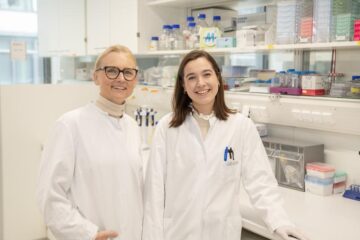Rapid wound healing

In Germany alone, about three million – mostly elderly – patients suffer from poorly healing large-area wounds caused by complaints such as diabetes, burns or bedsores. The wounds can be treated with conventional collagen dressings or polylactic acid dressings, but the success rate is not as good as it should be.
A new type of dressing made of silica gel fibers, developed by scientists at the Fraunhofer Institute for Silicate Research ISC in Würzburg, shall solve the problem. This novel dressing has many advantages: it is shape-stable, pH-neutral and 100 percent bioresorbable. Once applied it remains in the body, where it gradually degrades without leaving any residues.
What’s more, the fibre fleece provides the healthy cells around the edges of the wound with the structure they additionally need for a proper supply of growth-supporting nutrients. To prevent any infection, treatment of the wound must be absolutely sterile. “As only the outer bandage needs to be changed, the risk of contaminating the wound is low,” explains Dr. Jörn Probst of the ISC. And thanks to the supporting matrix for the cells, the chances of a scar-free natural closure of the wound are very good.
The fibers are produced by means of wet-chemical material synthesis, a sol-gel process in which a transparent, honey-like gel is produced from tetraethoxysilane (TEOS), ethanol and water in a multi-stage, acidically catalyzed synthesis process. The gel is processed in a spinning tower: “We press it through fine nozzles at constant temperatures and humidity levels,” explains Walther Glaubitt, the inventor of the silica gel fibers. “This produces fine endless threads which are collected on a traversing table and spun in a specific pattern to produce a roughly A4-sized multi-layer textile web.” The dressings are then cut, packed and sterilized. Dr. Jörn Probst and Dipl.-Ing. Walther Glaubitt will receive the Joseph von Fraunhofer Prize 2008 for developing the biocompatible dressing.
A partner to support the development and market the dressing has already been found: Bayer Innovation GmbH BIG, a wholly owned subsidiary of Bayer AG. “We anticipate that hospitals will start to use the silica gel wound dressing in 2011,” states Iwer Baecker, project manager at Bayer Innovation GmbH. And that is by no means the end of the story. The scientists plan to integrate active substances such as antibiotics or painkillers in the dressing to improve and accelerate the healing process.
Media Contact
All latest news from the category: Health and Medicine
This subject area encompasses research and studies in the field of human medicine.
Among the wide-ranging list of topics covered here are anesthesiology, anatomy, surgery, human genetics, hygiene and environmental medicine, internal medicine, neurology, pharmacology, physiology, urology and dental medicine.
Newest articles

Researchers have found brown fat’s “off-switch
Researchers from the University of Southern Denmark, the Novo Nordisk Center for Adipocyte Signaling (SDU), the University of Bonn and the University Hospital Bonn (UKB) have found a protein that…

Combining robotics and ChatGPT
TUM professor uses ChatGPT for choreographies with flying robots. Prof. Angela Schoellig has proved that large language models can be used safely in robotics. ChatGPT develops choreographies for up to…

How the Immune System Learns from Harmless Particles
Our lungs are bombarded by all manner of different particles every single day. Whilst some are perfectly safe for us, others—known as pathogens—have the potential to make us ill. The…





















